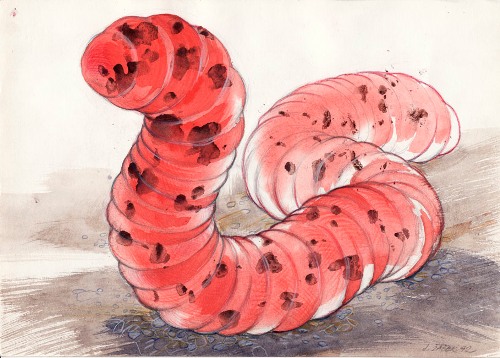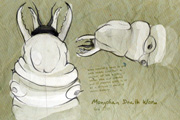
July 28, 2009

Illustration by Jiri Zacek/courtesy of Ivan Mackerle
Probably because the expedition leader works for New Zealand’s TV-3, journalist David Farrier has given rather exclusive information on his upcoming expedition to that station and NZPA. Scheduled to depart to Mongolia’s Gobi Desert on August 4, 2009, Farrier’s excursion will be in search of the Mongolian Death Worm.
The Death Worm is known by several names, including intestine worm, Allghoi Khorkhoi, and Orghoi Khorkhoy. It is said to resemble the creatures in Frank Herbert’s science fiction novel, Dune, or look like a cow’s intestine, measuring about 7.5 feet (1.5m) long, living under the sands of the Gobi.
Some thought has been given to this cryptid being an unknown species of giant spitting snake, but one needs to be caught for verification.

Artist Rob Farrier’s death worm illustration.
Part of what TV-3 and NZPA says about the story follows:
Auckland-based journalist David Farrier, who is organising the expedition, and Motueka-based cameraman Christie Douglas, leave on Tuesday to spend two weeks in the Gobi, trying to verify the [Death] Worm’s existence and making a documentary about it.
They will hire local Mongolians to help them; a guide, translator and cook.
Farrier, who works for TV3, told NZPA he had always been fascinated by cryptozoology, or the search for hidden creatures.
The expedition and documentary, which would cost him between $15,000 and $20,000, would take a serious look at the Worm and what it was, Farrier said.
He said he was interested in the Death Worm because it was one of the most outrageous creatures that were rumoured to exist.
However, it was also one of the mythical creatures that had a better chance of being real.
Rumours could inflate the reputation of things such as the Loch Ness Monster and Bigfoot, but sparsely populated Mongolia was not a place where rumours were going to propagate, Farrier said.
“If a Mongolian says they have seen a big worm-like creature out in the desert they haven’t really got any reason to lie.”
A number of experts have dismissed the Worm’s existence, putting it down as a rumour, but Farrier was not put off.
“I think it won’t be a worm, obviously a worm can’t survive in a desert. I’d say it would be some sort of snake that’s not meant to be there. It’s very out of place and a bit new.”
Farrier said there been up to four unsuccessful expeditions searching for the Death Worm in the last 100 years, the last two in 2003 and 2005, which had used night vision goggles to look for the Worm.
However, the New Zealand team planned to bring the Worm to the surface with explosives, as it is said to be attracted to tremors.
Farrier put his chances of finding the worm at between 5 and 15 percent.
“They are high for a ridiculous creature like the Death Worm but the area I am going to is a very specific place in the southern Gobi where all the sightings have been.”
He only plans to capture the worm on film.
“I have no intention of grabbing it, capturing it, stuffing it, or anything like that. I just want to prove its existence and if I can get it on film, that’s all I need to do.”
TV-3.
Explosives, humm? My sincere best wishes to Farrier and Douglas during their hunt for the Death Worm. I just hope their filming doesn’t turn into a version of some future movie entitled Mongolian Tremors rather than a serious documentary recording of a unique cryptozoological quest.
About Loren Coleman
Loren Coleman is one of the world’s leading cryptozoologists, some say “the” leading living cryptozoologist. Certainly, he is acknowledged as the current living American researcher and writer who has most popularized cryptozoology in the late 20th and early 21st centuries.
Starting his fieldwork and investigations in 1960, after traveling and trekking extensively in pursuit of cryptozoological mysteries, Coleman began writing to share his experiences in 1969. An honorary member of Ivan T. Sanderson’s Society for the Investigation of the Unexplained in the 1970s, Coleman has been bestowed with similar honorary memberships of the North Idaho College Cryptozoology Club in 1983, and in subsequent years, that of the British Columbia Scientific Cryptozoology Club, CryptoSafari International, and other international organizations. He was also a Life Member and Benefactor of the International Society of Cryptozoology (now-defunct).
Loren Coleman’s daily blog, as a member of the Cryptomundo Team, served as an ongoing avenue of communication for the ever-growing body of cryptozoo news from 2005 through 2013. He returned as an infrequent contributor beginning Halloween week of 2015.
Coleman is the founder in 2003, and current director of the International Cryptozoology Museum in Portland, Maine.
Filed under Breaking News, Cryptotourism, CryptoZoo News, Cryptozoologists, Expedition Reports